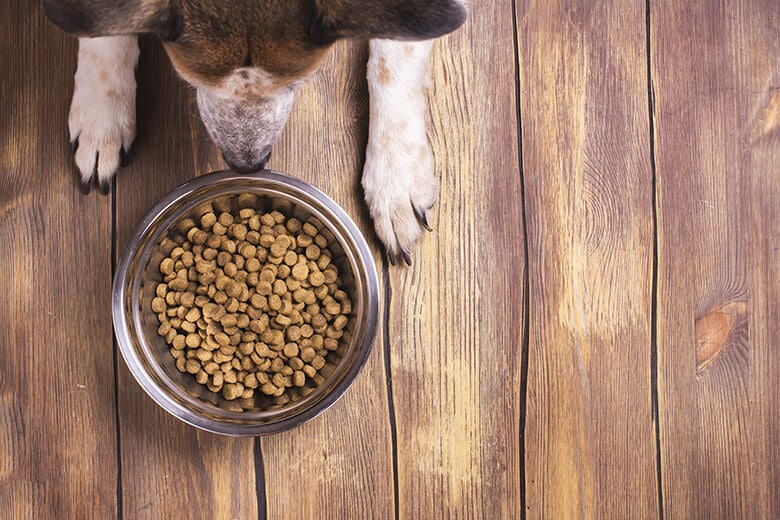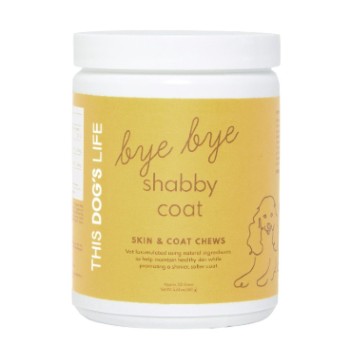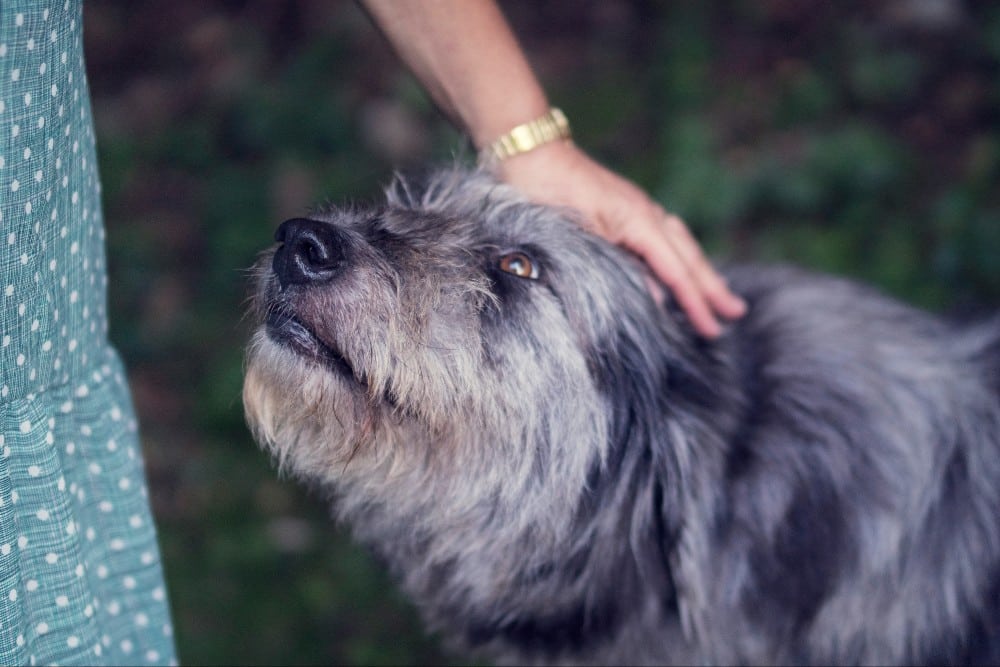This article is a condensed version of a guide published on NomNomNow.
Picture this: Your dog is constantly itching, scratching, and biting fur and you can’t figure out why. Maybe you’ve tried everything from changing grooming routines to special shampoos to medications. But have you tried changing your dog’s diet?
Food is one culprit behind allergic reactions in dogs that owners often overlook. In fact, there are dog food allergies and dog food intolerances. Just like us, canines can suffer from either or both. And food allergies in dogs can cause not only digestive problems like vomiting and diarrhea, but also skin issues, and even behavioral problems. If you or your vet suspect your pup may have be having an adverse reaction to certain foods, and you’re wondering what it all means, you’re in the right place.
We talked to Dr. Justin Shmalberg, a DVM and NomNomNow‘s veterinary nutritionist, to gather what you need to know when dealing with food allergies in dogs.
Related: 8 Large Breed Dogs That Don’t Shed or Make You Sneeze
Most Common Dog Food Allergens
Wondering what is in dog food that causes allergies? “Meat, dairy, and eggs are often thought to be the most common dog food allergens,” says Dr. Shmalberg. “Yet generally, it’s the protein part of those foods that tend to be problematic, rather than, say, the meat itself.” Keep in mind, veggies can contain protein, so they’re not automatically safe.
BMC Veterinary Research identified some of the most frequently reported dog food allergens involved in adverse food reactions. Here’s a look, from most-reported to least-reported.
Top Dog Food Allergens (source: BMC Veterinary Research)
| Dog Food Allergen | Percentage of Dogs With Reported Reaction |
| Beef | 34% |
| Dairy Products | 17% |
| Chicken | 15% |
| Wheat | 13% |
| Soy | 6% |
| Lamb | 5% |
| Corn | 4% |
| Egg | 4% |
| Pork | 2% |
| Fish | 2% |
| Rice | 2% |
Dr. Shmalberg calls out two important caveats to keep in mind here. First, newer research is needed. Many of the studies out there, and those sourced in this review, are older, when dog foods were being made and processed differently than they are today. Allergies tend to change over time along with foods, and as new studies emerge, we may see different allergens rising to the top of the list.
Second, the more common a food is, the more likely the allergy. “For an allergy to a food to develop, a dog needs to be exposed to that food,” says Dr. Shmalberg. “That may explain why the proteins most commonly found in dog food, like beef and chicken, fall higher on the list.”
Here are more facts about dog food allergens that are helpful to know:
Where there’s one allergy, there may be more. It’s estimated that more than a third of dogs with one food allergy are allergic to at least one additional food.
Starches are safer. Pure carbohydrates, aka starches, are pretty low in or free of protein, which means dogs usually aren’t allergic to them. There are exceptions: while potato starch is probably safe, whole potatoes might cause an allergy because they contain proteins. Same goes for higher-protein grains like corn and wheat. But overall, grain allergies are much less common than meat allergies.
With fats, purity matters. Pure fats, like a pure fish oil, are free of protein and shouldn’t trigger a response. But traces of protein can sneak into oils and fats during processing, and in a highly allergic dog, cause issues.
Look out for gelatin. Supplemental oils often come in gelatin capsules, and that gelatin can trigger allergies in some dogs.
Peanut allergies are rare in dogs. And if they do occur, they typically aren’t of the severity reported in some humans. Good news if your pup is one of the many who love a PB treat!
No two foods are exactly the same. There’s not a good deal of evidence to suggest that a dog who has a reaction to one food it is going to react to a similar food. That is, a dog allergic to chicken won’t necessarily be allergic to turkey.
Watch for additives. Chemicals, preservatives, colorants and flavorants aren’t likely to cause a true allergy, but they could trigger an adverse reaction or intolerance symptoms.
Food labels don’t always tell the whole story. Some non-fresh kibble and canned foods have tested positive for proteins even when they’re not listed on the label.
Dog Food Allergy Symptoms
Sneezing. Ear infections. Chronic Diarrhea. Restlessness. Dog food allergy symptoms run the gamut from skin reactions to gastrointestinal troubles to behavioral issues.
Below you’ll find a full list, broken down by category, to help you identify whether your pup might be suffering from a food allergy. Note: it’s estimated that about a quarter to a third of dogs with a food allergy also have environmental allergy, which “has similar, and at times indistinguishable, symptoms,” says Dr. Shmalberg.
Related: Our Favorite Products to Help Dogs Who Suffer From Summer Allergies
Most Common Signs of Food Allergies in Dogs
These are the signs you’ll see most often with a food allergy, says Shmalberg, starting with the single most common symptom: itching.
- Itching (aka pruritus)
- Sneezing
- Itchy paws
- Hot spots
- Skin rashes
- Scaly and/or oily skin
- Pigmented skin
- Leathery skin texture
- Eye discharge
- Red eyes
- Hair loss
- Ear infections
- Secondary yeast or bacterial infections (aka pyoderma) of the skin or ears
One study ranked the parts of the body most often involved in itching related to food allergies, as follows:
- Ears (involved 80 percent of the time)
- Paws (61 percent)
- Inner thigh/belly (53 percent)
- Eye or front leg area (33 percent).
Gastrointestinal Food Allergy Symptoms in Dogs
According to Shmalberg, only 10 to 30 percent of dogs with confirmed food allergies have gastrointestinal, or GI, symptoms like vomiting or diarrhea. “This is a condition that is much more often linked to skin symptoms,” he explains. “Sudden and short-lived GI symptoms are almost never caused by a food allergy. On the other hand, food allergies can contribute to or cause certain chronic symptoms.”
- Diarrhea with or without blood and/or mucus in stool
- Straining to pass stool
- Vomiting
- Abdominal pain
Rarer Symptoms of Food Allergies in Dogs
These symptoms aren’t as common as those above but may occur in some dogs.
- Nasal discharge
- Breathing issues
- Seizures (food allergies could trigger them in predisposed dogs)
- Secondary urinary tract infections (due to overgrowth of skin bacteria)
- Weight loss (in combination with severe diarrhea and/or vomiting)
Behavioral Symptoms
The symptoms below are also more rare and usually secondary to or linked to discomfort from symptoms listed above.
- Frequent scratching of self on furniture, owner’s legs, etc.
- Restlessness
- Frequent shaking ears or scratching ears
- Biting at paws, rear end, and/or tail
- Withdrawal or reduced interest in playtime
- Anorexia, or disinterest in or refusal of food
Long-Term Effects of Dog Food Allergies
If a food allergy goes untreated, there are some more serious health issues that could develop. These include secondary skin infections, development of more allergies, worsened symptoms, behavioral changes, and a poor quality of life.
It’s that last point that is most pertinent. “Usually animals don’t die from a food allergy, but it does affect their quality of life,” says Dr. Shmalberg. “If they’re itching all the time, it can feel like having a thousand mosquito bites all the time. While that’s not as catastrophic as something like organ failure, from a day-to-day standpoint, it can be pretty hard on the dog.” So, when a dog is feeling bad, that’s when you may start to see some of those behavioral issues listed above. To avoid chronic ailments and problems, diagnosis and treatment are crucial.
Dog Food Allergy Test and Other Diagnosis Methods
So, how can you tell if your dog is allergic to food? First, it’s helpful to know how you might distinguish a food allergy from an environmental one. “Environmental or flea allergies are far more common,” explains Shmalberg. If you suspect either of those, consult your vet, who can help identify and treat fleas, or do a combination of blood tests and/or intradermal allergy testing (which involves injections of potential allergens under the skin) to assess environmental allergies.
Related: 7 Fast-Acting and Effective Home Remedies to Stop Your Dog From Getting Fleas
But if your dog has the following signs, talk to your vet about setting up a dog food allergy test or elimination diet.
Telltale Signs Your Dog May Have a Food Allergy (vs. an Environmental or Flea Allergy):
If the symptoms occur at a very young age—typically, puppies younger than age 1 don’t experience environmental allergies
If the symptoms aren’t tied to a seasonal change or don’t change in different parts of the country (e.g. if you travel or move with your dog from a dry climate to a humid one)
If the reaction doesn’t respond to steroids
If your dog has both skin and gastrointestinal symptoms
Dog Elimination Diet
The most reliable way to diagnose a food allergy is to feed your dog something entirely new, and relatively pure, for at least eight weeks. For accurate results, you’ll need to feed a non-contaminated simple ingredient diet (it can be commercial or cooked) for the entire trial. Most importantly, says Dr. Shmalberg, “the diet should include a single-source animal or vegetable protein and a single source of carbohydrate calories, without other natural flavors (that could have unidentified proteins)—and it must be a food your pet hasn’t had in the past. Classic examples include venison and potato, rabbit and pea, and fish and potato.”
It’s also important you refrain from feeding treats, table scraps, snacks, and flavored medications and supplements of any kind that don’t match the specific ingredient combo you’re using for the trial. After eight weeks, to truly prove the food allergy, you must then feed the original food—the suspected allergic protein or proteins—again. If there’s a reaction or breakout at that point, that’s a pretty good indication of an allergy.
“The reality is that most owners don’t complete this part, as they don’t want their dog to have symptoms again,” says Dr. Shmalberg. “An owner might just continue to feed the trial food if it seems to be agreeing with the dog.” But reintroducing the suspected allergens is really the only way to confirm an allergy. Dr. Shmalberg suggests cycling through potential allergens one by one—chicken, beef, egg, dairy—to see what does (and does not) trigger symptoms.
Other Types of Dog Food Allergy Testing
Aside from elimination diets, there are a couple of other test options worth a look.
Blood tests: Blood tests exist, but they’re not very accurate. “There are new food allergy blood tests in development, which appear better than those on the market,” says Dr. Shmalberg. “That means, for now, a food elimination diet is the best option.
Patch tests: Patch tests are generally thought to be more accurate than blood tests. Yet, according to Dr. Shmalberg, “They’re not commonly done but may be offered in a dermatology clinic, where a protein (e.g. beef) is mixed with petroleum jelly and taped on the skin for about two days, then tested a day later. If there’s irritation (redness, hives), it’s considered a positive test; if not, it’s negative.
Dog Food Allergy Treatment
Dog food allergy treatment boils down to one underlying principle: identify foods your dog is allergic to and avoid feeding him those. “That’s why the elimination diet and trial period is so essential,” says Dr. Shmalberg, “as it’s the only way to identify which foods, and food proteins, a dog can tolerate and which he can’t.” Now, if it’s a food intolerance rather than an allergy (which is far more likely), a food trial is still helpful, but a simple change of diet can be just as effective. “A diet with a different composition from the one currently being fed is often enough to improve symptoms,” Dr. Shmalberg explains.
Aside from that, there are a few other tactics that come up in dealing with food allergies and intolerances. Here’s a brief overview, plus considerations, pros, and cons for each.
Antihistamines and Other Medications
Antihistamines like Benadryl can minimize itching, and they’re relatively safe and vet-approved for use at home. Topical anti-itch shampoos and ointments may help too—just be sure to get your vet’s OK before giving your dog any over-the-counter medication or remedy. Antibiotics and antifungals like cephalexin and ketoconazole, for example, may help in the short term to treat secondary infections that occur when the skin is inflamed, “but symptoms usually recur after stopping,” says Dr. Shmalberg. As for anti-inflammatory medications like steroids? “They typically don’t do anything to help many food allergy symptoms,” he says.
Homemade Diets
Homemade diets are sometimes used for elimination diet food trials, and for dogs with food intolerances or allergies. It’s easy to see why they’re effective—the owner has total control over the ingredients. But there’s an issue with homemade dog food diets. “Unless formulated well, with the advice of a veterinary nutritionist, many are deficient in certain critical nutrients,” says Dr. Shmalberg, “and those deficiencies could cause issues in the long run.” The preparation is labor-intensive for the owner, too.
Vegan Diets
Likewise, vegan diets are used by some owners and veterinarians during and after food trials, but there’s no evidence they’re more favorable than a carefully selected diet with a single protein. (In fact, vegan diets often include a lot of different vegetable proteins.) But if a dog is allergic to multiple meats, a vegan diet is certainly one way to avoid them. Like homemade diets, vegan diets must be carefully formulated. “Some store-bought vegan diets were found to be deficient in critical nutrients, and they’re really only mentioned by vets because they’re becoming more and more popular among owners,” says Dr. Shmalberg. “It’s definitely not our top choice for treating food allergies.”
Best Dog Food for Allergies
When it comes down to it, there is no one best dog food for allergies. “It’s very dependent on the individual dog,” says Shmalberg. “But it’s important to know what’s in your dog’s food, and be confident that it’s made without contamination from ingredients that aren’t listed on the label.” That’s why, when you’re looking for a dog food without allergens, canned food and kibble can be tricky. With foods that are made fresher, and in smaller batches, you can see what’s in it, and traces of allergic ingredients are less likely to slip in during processing. This is exactly why many owners consider making their own dog food. “It’s all dependent on the cooking process and ingredient quality, and many conventional diets have had issues with cross-contamination, according to published studies,” says Shmalberg.
Here are his tips for choosing a diet for a dog with food allergies or intolerances:
Change things up. If you or your vet thinks your dog has a food intolerance, it’s worth it to switch to a diet with a different protein source, with varied ingredients, and maybe even a different fat level. “These diets don’t need to be as simple as the ones used in elimination diets,” says Dr. Shmalberg.
Commercial food labels aren’t always accurate. One 2018 research review determined, after looking at a number of studies about commercial pet foods, about 45 percent of them had unlabeled ingredients, including products claiming “limited ingredients.” The review did find that diets with hydrolyzed, or chemically broken-down, ingredients didn’t have near the rate of unlabeled ingredients (probably because hydrolyzation is a very technical process).
Related: We Compared the Top Dog Food Delivery Companies on Ingredients, Price and What Makes Them Special
Dog food products aren’t regulated for purity. Big-batch cooking in a big plant involves a lot of heavy machinery with a lot of nooks and crannies—where it’s easy for contamination to happen. “Companies that make ‘hypoallergenic’ or ‘limited ingredient’ dog foods should be following best practices to eliminate this,” says Dr. Shmalberg, “but there’s no oversight or regulation of the manufacturing of these types of products.”
Fresh food might be a safer bet. When you choose a food that’s freshly prepared in small batches, with a few human-grade ingredients and no artificial fillers, you can see exactly what your pup is getting. Homemade dog food is one option. If you’d rather not spend time preparing your dog’s food, consider a made-from-scratch, small-batch dog food delivery service that emphasizes quality and purity.
To read the guide in its entirety, head over to NomNomNow.
Bye Bye Shabby Coat nourishes your dog’s skin and coat from the inside out. Veterinarian formulated and using powerful natural ingredients, including healthy omegas, salmon oil, and vitamin E, our chews help heal dry, itchy, irritated skin, while also promoting a shinier and softer coat. All our supplements are proudly manufactured in the USA.




















